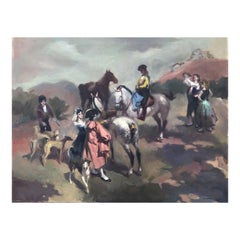Monederos Vintage
Recent Sales
1970s Expressionist Monederos Vintage
Canvas, Oil
Manuel Monedero for sale on 1stDibs
Manuel Monedero was a Spanish painter. His first exhibition dates from 1961 at the Dickson Gallery in Washington. During the decade of the 60s, he exhibited in the USA. UU., From its federal capital, to Philadelphia, Baltimore, New York, Houston, Princeton, California, as well as in the Canadian city of Montreal, always in prestigious galleries (Dickson, Lesnick, Delancey, Gorline, etc.). Monedero received influences from Hohenleiter and especially from his friend Baldomero Romero Ressendi. His first Spanish exhibition took place in 1965 in his hometown (Florencia Gallery). Monedero exhibited four times in Madrid, two with Heller and two with Cano, between 1973–79. Thereafter, he took refuge in the Huelva village of Carboneras, where he worked endlessly. It was not until May 1993, when he was honored in Seville with an Anthological Exhibition in the Image Room, which received the applause of criticism and the unusual heat of the public. Monedero had no disciples, but followers. He died in Carboneras (Huelva) on December 6, 2002.
A Close Look at expressionist Art
While “expressionist” is used to describe any art that avoids naturalism and instead employs a bold use of flattened forms and intense brushwork, Expressionist art formally describes early-20th-century work from Europe that drew on Symbolism and confronted issues such as urbanization and capitalism. Expressionist artists experimented in paintings and prints with skewed perspectives, abstraction and unconventional, bright colors to portray how isolating and anxious the world felt rather than how it appeared.
Between 1905 and 1920, Austrian and German artists, in particular, were inspired by Postimpressionists such as Paul Gauguin and Vincent van Gogh in their efforts to strive for a new authenticity in their work. In its geometric patterns and decorative details, Expressionist art was also marked by eclectic sources like German and Russian folk art as well as tribal art from Africa and Oceania, which the movement’s practitioners witnessed at museums and world’s fairs.
Groups of artists came together to share and promote the themes now associated with Expressionism, such as Die Brücke (The Bridge) in Dresden, which included Erich Heckel, Ernst Ludwig Kirchner and Karl Schmidt-Rottluff and investigated alienation and the dissolution of society in vivid color. In Munich, Der Blaue Reiter (The Blue Rider), a group led by Wassily Kandinsky and Franz Marc, instilled Expressionism with a search for spiritual truths. In his iconic painting The Scream, prolific Norwegian painter Edvard Munch conveyed emotional turmoil through his depiction of environmental elements, such as the threatening sky.
Expressionism shifted around the outbreak of World War I, with artists using more elements of the grotesque in reaction to the escalation of unrest and violence. Printmaking was especially popular, as it allowed artists to widely disseminate works that grappled with social and political issues amid this time of upheaval. Although the art movement ended with the rise of Nazi Germany, where Expressionist creators were labeled “degenerate,” the radical ideas of these artists would influence Neo-Expressionism that emerged in the late 1970s with painters like Jean-Michel Basquiat and Francesco Clemente.
Find a collection of authentic Expressionist paintings, sculptures, prints and more art on 1stDibs.
Finding the Right animal-paintings for You
Animal paintings depict the beauty and power of nature in an elegant way that can complement any room. Interacting with animals has long captured the imagination and has been interpreted in diverse artistic media.
Some of the oldest works of art have included animals, such as a cave painting found in Indonesia dating back more than 45,500 years that shows a wild pig in red ocher pigment. Animals have continued to appear in every era and style of art, from realism to Pop art and everything in between.
Some paintings portray animals in their natural habitat, highlighting the majesty of wild creatures roaming the plains, forests and jungles. These paintings often feature deer, tigers, wild mustangs and other wildlife. Others focus on domestic animals such as dogs — pay a visit to the Museum of the Dog if you don’t believe us — as well as cats and how they interact with the world and their owners.
Picking the right animal painting for a room — as well as knowing how to arrange your new wall art — can take time. But, in the end, it will tastefully reflect your interests and passions. While an expansive landscape painting helps open up a small space, hanging a horse painting in a den shows a love for equine culture and can invite interesting conversation.
There is animal art to fit every collection on 1stDibs. Explore a wide selection of animal paintings and animal prints in a range of styles and designs to match any home or office.
